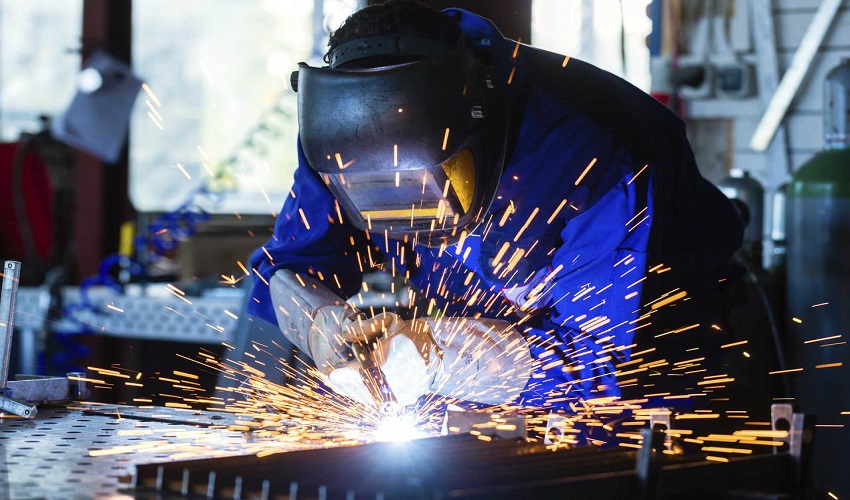Expert Steel Fabricators Melbourne: Quality You Can Depend On
Expert Steel Fabricators Melbourne: Quality You Can Depend On
Blog Article
Innovative Trends in Steel Fabrication: Enhancing Sturdiness and Precision
In the realm of steel manufacture, the quest of longevity and accuracy has brought about a wave of ingenious fads that are reshaping the sector. From improvements in welding innovations to the combination of robot automation in construction procedures, the landscape of steel production is progressing quickly. High-strength alloy advancement, coupled with the usage of 3D modeling and simulation software program, is pushing the boundaries of what is attainable in regards to architectural integrity and precision. The expanding focus on sustainable practices in steel manufacturing is not only driving effectiveness but additionally fostering a much more ecologically mindful approach to manufacture. These patterns are not just forming the here and now however likewise preparing for the future of steel fabrication, promising further enhancements in durability and precision.
Advanced Welding Technologies
In the world of steel fabrication, the fostering of cutting-edge welding modern technologies has actually dramatically revolutionized the market's technique to achieving premium high quality and accuracy in structural welds. Advanced welding innovations, such as laser beam of light welding and friction stir welding, have arised as game-changers in the field. By leveraging these sophisticated welding methods, steel producers can elevate the longevity, stamina, and precision of their structural welds, meeting the increasingly requiring needs of modern construction projects.
Robot Automation in Manufacture
Accepting robot automation has actually come to be a keystone of modern steel manufacture techniques, enhancing and streamlining processes effectiveness throughout the sector. Robots are transforming the means steel components are produced, supplying unrivaled precision and rate while lowering human error. These automated systems can manage repetitive tasks with consistent precision, leading to better final result.
One secret benefit of robotic automation in steel construction is the ability to work around the clock without tiredness, dramatically raising production output. This constant operation lessens downtime and increases task timelines, inevitably saving costs for suppliers. In addition, robots can be configured to perform complex tasks that might be difficult or harmful for human employees, enhancing safety in the office.
Moreover, robot automation allows seamless combination with other digital modern technologies, such as computer-aided design (CAD) software and Internet of Things (IoT) systems (steel fabrication melbourne). This interconnected strategy enhances interaction between various phases of construction, maximizing workflows and guaranteeing real-time surveillance and control. As the steel manufacture sector proceeds to develop, robotic automation stands out as a transformative force driving effectiveness and precision in making processes

High-Strength Alloy Growth
The advancement of high-strength alloy growth in steel construction is reshaping the sector's strategy to boosting product longevity and performance. High-strength alloys are engineered to display remarkable mechanical properties, such as increased tensile toughness, durability, and rust resistance compared to conventional steel qualities. By integrating these innovative alloys right into manufacture procedures, manufacturers can produce components that withstand higher stress and anxiety levels and rough environments, bring about more resilient and reputable output.
One key advantage of find more info high-strength alloy growth is the capability to minimize product density without endangering structural integrity. This not only causes lighter-weight parts however likewise adds to set you back savings and boosted performance in manufacture and setting up processes. Furthermore, the boosted strength-to-weight proportion of these alloys enables for the layout and construction of frameworks with higher load-bearing capacities while reducing general weight.
3D Modeling and Simulation Software
Developments in steel construction procedures have been considerably pushed by the assimilation of innovative 3D modeling and simulation software tools. These tools allow producers to develop detailed digital models of their projects, allowing them to envision the last item with accuracy before any physical job starts.

Sustainable Practices in Steel Manufacturing
Including sustainable techniques right into steel production procedures is crucial for decreasing environmental influence and making certain lasting resource availability. One key lasting technique is the adoption of energy-efficient modern technologies to minimize greenhouse gas discharges during the steel production procedure. This consists of utilizing renewable resource resources, such as solar or wind power, to power steel plants and applying energy-efficient devices to optimize power usage.
One more important element of lasting steel manufacturing is the liable sourcing of raw materials. This entails making certain that the iron ore and other sources made use of in steelmaking are gotten from honest and environmentally friendly sources. By advertising transparency in the supply chain and adhering to strict ecological requirements, steel manufacturers can minimize the adverse effects of source extraction on regional ecological communities and areas.

Final Thought
To conclude, the innovative trends in steel fabrication such as sophisticated welding technologies, robotic automation, high-strength alloy development, 3D modeling and simulation software application, and lasting techniques are boosting the resilience and precision of steel items. These find out here now developments are changing the steel fabrication industry by boosting top quality, sustainability, and efficiency. It is clear that the future of steel construction hinges on embracing these sophisticated innovations to fulfill the demands of modern-day construction and production industries.
In the world of steel fabrication, the quest of durability and accuracy has led to a wave of innovative trends that are reshaping the sector.In the world of steel manufacture, the adoption of advanced welding technologies has dramatically revolutionized the market's method to accomplishing exceptional quality and accuracy in architectural welds. As the steel construction sector proceeds click to read to progress, robotic automation stands out as a transformative pressure driving effectiveness and accuracy in manufacturing processes.
Furthermore, reusing and reusing steel scrap and waste products play a considerable role in boosting the sustainability of steel production. steel fixing.In final thought, the ingenious patterns in steel fabrication such as advanced welding innovations, robot automation, high-strength alloy growth, 3D modeling and simulation software application, and sustainable practices are improving the sturdiness and precision of steel products
Report this page